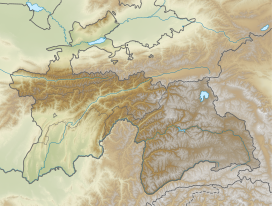| Sarikol Range Сарыкольский хребет Қаторкӯҳи Сариқӯл 萨雷阔勒岭 | |
|---|---|
 | |
| Highest point | |
| Peak | Mount Lyavirdyr |
| Elevation | 6,351 m (20,837 ft) |
| Coordinates | 38°38′N 74°30′E / 38.633°N 74.500°E / 38.633; 74.500 |
| Dimensions | |
| Length | 350 km (220 mi) N/S |
| Width | 35 km (22 mi) E/W |
| Geography | |
| Country | Tajikistan / China |
| Parent range | Pamir Mountains |
| Geology | |
| Rock age | Paleozoic |
| Rock type(s) | Granite, schist and gneiss |
The Sarikol Range (Russian: Сарыкольский хребет; Chinese: 萨雷阔勒岭, 色勒库尔山脉; Tajik: Қаторкӯҳи Сариқӯл) is a mountain range in the Pamirs on the border of Tajikistan and the People's Republic of China.
Etymology
The mountain range is named for the Sarikol River at its foot, the name of which comes from the Kyrgyz Сарыкол, Sarıqol, which is composed of сары, sarı, 'yellow', and кол, qol, 'river', meaning "yellow river". In this toponym, the word кол, qol, 'river', originates neither from the Kyrgyz кол, qol, 'arm', nor from the Kyrgyz көл, köl, 'lake', but rather from the Mongolian гол, gol, 'river'.
The name has also been used to describe the local people who are historically known as Sarikolis; the local Sarikoli language, and the town of Tashkurgan, which was historically known as Sarikol.
Geography
The range divides Tajikistan's Gorno-Badakhshan Autonomous Province and China's Xinjiang Uyghur Autonomous Region and it runs parallel with the Muztagh Range to the east. The range extends 346 kilometres (215 mi) from the Markansu River in the north to the Beyik Pass in the south. Its average elevation is roughly 5,000 metres (16,500 ft) and the highest point in the range is Mount Lyavirdyr at 6,351 m (20,837 ft). On the Tajik part of the range there are 240 glaciers with a total area of 144 km. The range's drainage basin feeds both the Amu Darya and Tarim River. The range is composed of schist, granite and gneiss.
See also
References
- Central Asian Review. Vol. 4. Central Asian Research Centre. 1962 – via Google Books.
Certain Mongolian terms have already entered the vocabulary of the Kirgiz language as its own. In Mongolian toponymy the word "gol" meaning river is extremely widespread. In Kirgiz geographical nomenclature the term "kol" used in the same sense is common (it should not be confused with "kël'", "kul'" - lake). In the Tyan'-Shan' and Pamirs dozens of rivers can be called by the name of Karakol, Sarykol, Muzkol, which writers have translated as: black arm, yellow arm, icy arm. There is little meaning in such translations, and in fact they are incorrect. In the Inner Tyan'-Shan' there are Mongolian geographical names which have been completely preserved. An example is the form Dzhumgol, Dzhumgal, which is easily translated as eastern or left-land river. In fact, the Dzhumgol is the left-hand tributary of the Këkëmeren.
- Сарыкольский хребет - article from the Great Soviet Encyclopedia
- "Sarykol Range", Encyclopædia Britannica, 2010-04-17
This Xinjiang location article is a stub. You can help Misplaced Pages by expanding it. |
This Tajikistan location article is a stub. You can help Misplaced Pages by expanding it. |
| Gorno-Badakhshan | ||
|---|---|---|
| Capital: Khorugh | ||
| Districts |  | |
| Main cities and towns | ||
| Geography | ||
| Rivers | ||